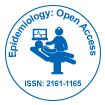开放获取期刊获得更多读者和引用
700 种期刊 和 15,000,000 名读者 每份期刊 获得 25,000 多名读者
索引于
- 哥白尼索引
- 谷歌学术
- 夏尔巴·罗密欧
- Genamics 期刊搜索
- 安全点亮
- 访问全球在线农业研究 (AGORA)
- 国际农业与生物科学中心 (CABI)
- 参考搜索
- 哈姆达大学
- 亚利桑那州EBSCO
- OCLC-世界猫
- CABI 全文
- 出租车直达
- 普布隆斯
- 日内瓦医学教育与研究基金会
- 欧洲酒吧
- ICMJE
有用的链接
开放获取期刊
分享此页面
抽象的
Prevalence of Malaria and Associated Factors among Febrile Patients Visiting Kalala Health Center in Haro Limmu Woreda, East Wollega Zone, Western Ethiopia, 2016
Kassahun Tegegne Bidu and Zalalem Kaba Babure
Background: Malaria is caused by protozoan parasites that belong to the Genus Plasmodium that are transmitted to human via the bite of infected female Anopheles mosquito. 34(75%) of the land mass of Ethiopia is malarious with two-thirds of the country’s population at risk of acquiring infection. The distribution and transmission of malaria in Ethiopia varies from place to place. Risk of malaria is highest in the western lowlands of Oromia, Amhara, Tigray and almost the entire regions of Gambella and Benishangul Gumuz regions.
Objective: To determine prevalence of malaria and associated factors among febrile patients visiting Kalala health center, Haro Limmu Woreda.
Methods: A cross-sectional study was carried out among 316 febrile patients visiting Kalala health center, from October 15 to November 15, 2016. Face to face interview was conducted using pre-tested structured questioner. Blood sample was collected and thick and thin smears were prepared and examined microscopically for the presence of malaria parasite. Data generated from the study was analyzed using SPSS statistical software version 20.0.
Results: From all study participants, 184(58.2%) were male and 132(41.8%) were female with mean age of 29.48(SD ± 16.12) years and 36(10.0%) were 5 years. From febrile cases visited Kalala health center 49.4% were positive for malaria, in which 54.5%, 15.8% and 6.6% were infected with Plasmodium falciparum, Plasmodium vivax and mixed respectively. Being female, rural residence, age group 25 to 34 and 45 to 54, lack of access to radio, not using ITNs, occupation, educational status and not taking anti malaria drug were significantly associated with malaria.
Conclusion and Recommendation: The prevalence of malaria in study area is high with dominancy of Plasmodium falciparum which needs attention of community and governments to tackle at grass root level by increasing level of knowledge and practice towards malaria prevention and control strategy.

 English
English  Spanish
Spanish  Russian
Russian  German
German  French
French  Japanese
Japanese  Portuguese
Portuguese  Hindi
Hindi